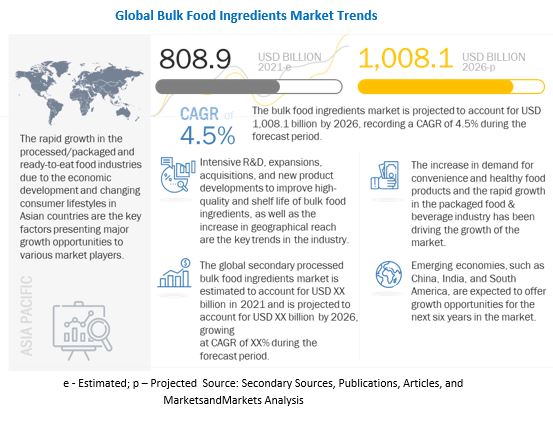The bulk food ingredients market is estimated at USD 808.9billion in 2021 and is projected to grow at a CAGR of 4.5% to reach USD 1,008.1billion by 2026.Increasing health awareness and spending power among people has fueled growth in the beverage and dairy industries, thus driving the growth of bulk food ingredients market. With increasingly busy schedules and rising health awareness, consumers are shifting to functional food & beverages to meet their nutritional requirements. In addition to it, the per capita consumption of dairy products has also increased, due to the increasing per capita spending on healthy food and drinks. The demand for beverages such as flavored water and milk and carbonated soft drinks is increasing in emerging economies, especially in AsiaPacific. The global primary processed bulk food ingredients market size is estimated to be valued at USD 338.74 billion in 2021. It is projected to reach USD 419.47 billion by 2026, recording a CAGR of 4.4% during the forecast period.The global secondary processed bulk food ingredients market size is estimated to be valued at USD 470.19 billion in 2021. It is projected to reach USD 588.64 billion by 2026, recording a CAGR of 4.6% during the forecast period.
Download PDF brochure: https://www.marketsandmarkets.com/pdfdownloadNew.asp?id=2141018

Bulk food ingredients refer to all the food items that can be procured and processed in large quantities and are transported in a bulk container. These ingredients are priced lower than packaged foods due to the low cost of packaging involved. These ingredients include nuts; oilseeds; herbs & spices; grains, pulses, and cereals; sugar; tea, coffee, and cocoa; salt, dried vegetables, and citric acid. They can be consumed either after primary processing, which includes cleaning, sorting, and grading, or secondary processing, which includes drying, breaking, and grinding ingredients. In primary processing, raw materials are minimally processed into commodity ingredients whereas in secondary processing, ingredients are converted into edible products.
The food segment accounted for the highest value of USD 354.19 billion in 2020; it is projected to grow at a CAGR of 4.6% from 2021 to 2026 due to the growing middle-class population and urbanization, which has led to an increase in the disposable income of people. The applications of bulk food ingredients in the food industry considered in this study include bakery products, confectionery products, snacks & spreads, ready meals, infant formulas, and dairy products. The growing middle-class population and rapid urbanization have led to an increase in disposable income of people, particularly in developing nations, which has ultimately led to an increase in demand for high-quality natural food products.
North America has the potential for manufacturing new bulk food ingredients and is projected to play an important role in the global market. The market for bulk food ingredients in North America has reached a maturity stage, due to which its growth is moderate. The market is favorable for innovative and new products of improved and enhanced quality.The consumers in this market are looking out for minimally processed convenience food products of high quality. This has heightened the need for appropriate food safety regulations and has also meant that the role of ingredients to improve palatability, multi-functionality, and versatility has become increasingly important and critical. The increase in demand for higher convenience acts as an important factor that encourages the demand for bulk food ingredients. Consumers are looking out for ready-to-eat food products that offer them a good experience, save time, and can be consumed on the go.Make an Inquiry:https://www.marketsandmarkets.com/Enquiry_Before_BuyingNew.asp?id=2141018